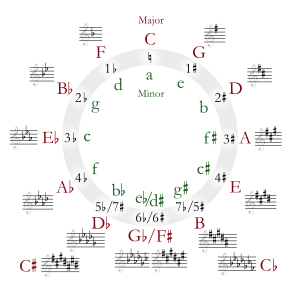D-sharp minor facts for kids
 |
||
| Relative key | F♯ major | |
|---|---|---|
| Parallel key | D♯ major enharmonic: E♭ minor |
|
| Notes in this scale | ||
| D♯, E♯, F♯, G♯, A♯, B, C♯, D♯ | ||
D-sharp minor is a minor scale that starts on the note D sharp. A musical scale is a set of notes played in a specific order. For the harmonic minor version of D-sharp minor, the note C sharp becomes C double-sharp. This scale's key signature has six sharps.
D-sharp minor has an enharmonic twin called E-flat minor. This means they sound the same but are written differently. Its relative major is F-sharp major. The parallel major is D-sharp major. However, D-sharp major is rarely used because it has many double sharps, making it hard to read. Instead, E-flat major is often used.
Contents
What Makes D-sharp Minor Special?
Both D-sharp minor and its twin, E-flat minor, have key signatures with six sharps or flats. This means neither one is much easier to use than the other. For example, playing D-sharp minor on a harp can be tricky. The harp's pedals can make notes sharp, but not double-sharp.
Even famous composers like Bach sometimes chose between these two keys. In one of his works, The Well-Tempered Clavier, Bach wrote the eighth prelude in E-flat minor. But he wrote the matching fugue in D-sharp minor. Later, in Book II, he used D-sharp minor for both the prelude and the fugue.
Why This Key Is Not Common
Music written in D-sharp minor can be quite hard to read. Because of this, composers in the Classical era did not use it very often. For many brass and woodwind instruments, E-flat minor is usually easier to play.
Despite its challenges, some composers have written famous pieces in D-sharp minor. The most well-known is Scriabin's amazing Etude Op. 8, No. 12. Another Russian composer, Lyapunov, also liked this key. He wrote the second etude of his Op. 11 set in D-sharp minor. Fifteen years later, he used it for his Variations on a Russian Theme, Op. 49. His early Piano Concerto No. 1, Op. 4, was in the related key of E-flat minor.
Using D-sharp Minor in Music
D-sharp minor is not often used in music for a full orchestra. However, it appears more frequently in music written for keyboard instruments, like the piano.
When someone wants to arrange piano music in D-sharp minor for an orchestra, they might change the key. This process is called transposing. They might transpose the music to an easier key like D minor or E minor. If D-sharp minor must be used, parts for B-flat wind instruments are usually written in F minor, not E-sharp minor. This makes the music easier for the musicians to read and play.
Scales and Keys
| Diatonic Scales and Keys | |||||||||||||||||||||||||||||||||||||||||||||||||||||||
|---|---|---|---|---|---|---|---|---|---|---|---|---|---|---|---|---|---|---|---|---|---|---|---|---|---|---|---|---|---|---|---|---|---|---|---|---|---|---|---|---|---|---|---|---|---|---|---|---|---|---|---|---|---|---|---|
|
|||||||||||||||||||||||||||||||||||||||||||||||||||||||
| The table shows the number of sharps or flats in each scale. Minor scales are written in lower case. | |||||||||||||||||||||||||||||||||||||||||||||||||||||||
See also
 In Spanish: Re sostenido menor para niños
In Spanish: Re sostenido menor para niños


